Review: Catching up with Doctor Who and Ncuti Gatwa’s stellar freshman season
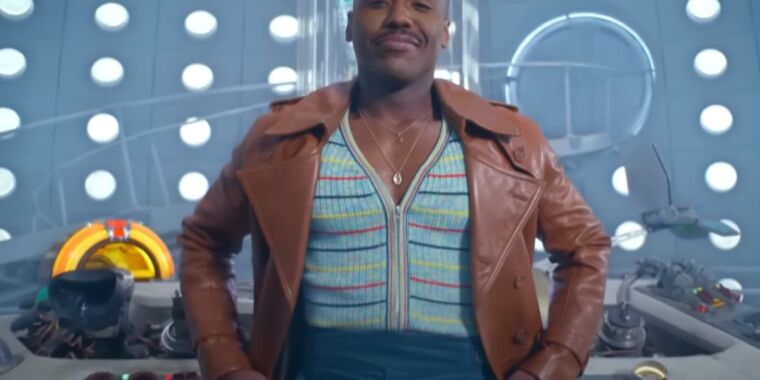
“Hello, sweetie” —
The Sex Education actor brings sparkling energy, charisma, and superb style to the role
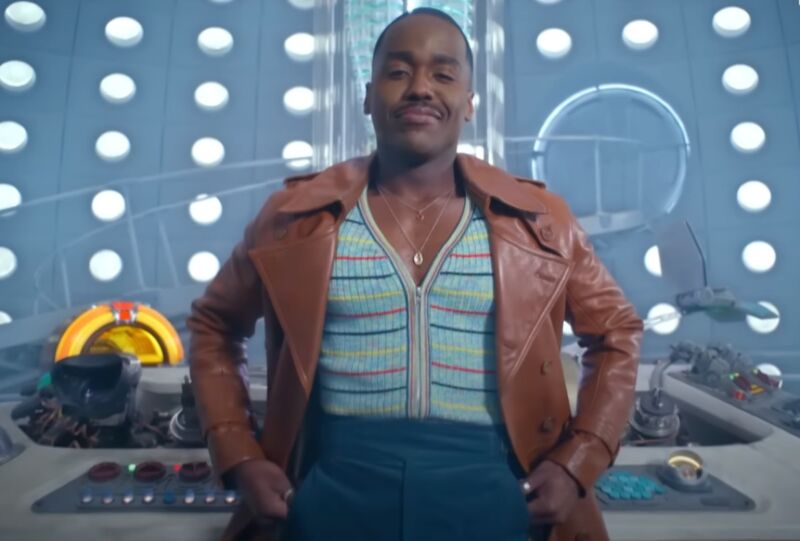
Enlarge / Ncuti Gatwa wrapped his first full season as the Fifteenth Doctor and proved more than up to the challenge.
YouTube/BBC
Doctor Who is now in its 61st year featuring a host of gifted British actors each taking on the iconic role in turn. So Ncuti Gatwa had some very big shoes to fill when he took on playing the Fifteenth Doctor. Now the season has concluded and the verdict is in: Gatwa is more than up to the challenge, bringing sparkling energy, charisma, and a superb sense of style to the role. He sings and dances, too, as does winsome new companion Ruby Sunday (Millie Gibson). They have terrific onscreen chemistry and Davies is in top storytelling form. In short, the new season mostly feels as fresh and energetic as ever and I’m already looking forward to more.
(Spoilers below.)
Here’s a brief summation for the benefit of those who may not have kept up with the more recent seasons. This is Russell T. Davies’ second stint as showrunner, having revived the series in 2005. He lost no time introducing a few new twists after signing back on as show runner. When it came time for Jodie Whittaker’s Thirteenth Doctor to regenerate, fans had expected Gatwa to be introduced. Instead, the new Fourteenth Doctor was played by former Tenth Doctor David Tennant, reuniting with former companion Donna Noble (Catherine Tate) for three specials.
The third special was called “The Giggle.” During the climactic battle, the Doctor was shot. But instead of the usual regeneration, the Fourteenth Doctor “bigenerated” instead, resulting in both a Fourteenth Doctor and Gatwa’s Fifteenth Doctor, a separate physical entity. Tennant’s incarnation settled into a comfy retirement with Donna and her family, while Gatwa’s newly regenerated Doctor headed off for a fresh set of adventures.
In the Christmas special, “The Church on Ruby Road,” Gatwa’s Doctor picked up a new companion: Ruby Sunday, a young woman abandoned at a church on Christmas Eve and raised by her foster mother. Goblins kidnapped the new foster baby, Lulubelle, to feed her to the Goblin King in a ritual sacrifice involving a rather silly goblin song. Ruby and the Doctor joined forces to save her. Naturally Ruby decided to join him for a few more adventures in the TARDIS. (You can read our interview with Davies, Gatwa, and Gibson here.)

Enlarge / “Space babies!”
YouTube/BC
The Doctor and Ruby kicked things off by rescuing a group of talking “space babies’ on an abandoned baby farm space station who were being terrorized by a monstrous Bogeyman (made, as it turns out, from actual “bogies” aka snot). It’s a clever standalone concept that never quite gels, despite the charm of seeing babies in motorized strollers operating Rube-Goldberg-like systems to perform basic tasks on board the ship. But it works well as an appetizer for what’s to come.
By contrast, “The Devil’s Chord” is a classic Whovian adventure, in which the Doctor and Ruby must save the world from a powerful being called Maestro (Jinkx Monsoon), child of the Toymaker (arch-villain of “The Giggle”). Unwittingly summoned by a piano teacher playing the “devil’s chord” in 1925, Maestro has been robbing the universe of music, intent on leaving nothing but Aeolian tones. So when the Doctor and Ruby crash a Beatles recording session in 1963, they are dismayed to hear the Fab Four play a decidedly uninspired tune about Paul McCartney’s dog rather than one of their future hits. Everything works in this episode, from Monsoon’s maniacal cackle to the fabulous outfits and sly visual callback to the Abbey Road album cover (not to mention the famous keyboard scene in Big). Bonus points for the big musical number at the end, taking advantage of Gatwa’s and Gibson’s natural talents.
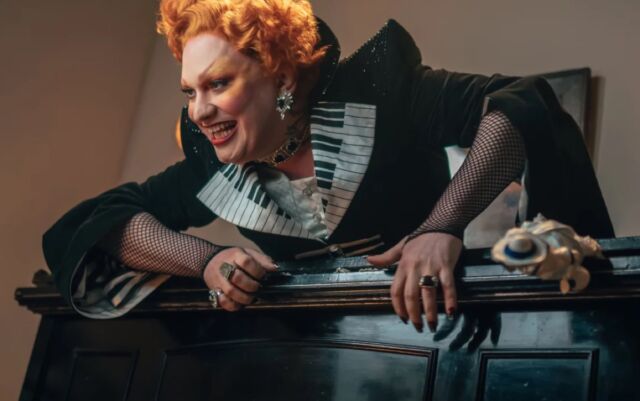
Enlarge / Jinkx Monsoon as Maestro, who is robbing the universe of all music.
BBC/Disney+
The Bridgerton references run wild in the delightful “Rogue,” as the Doctor and Ruby travel to Regency England and discover a group of “cosplaying” shapeshifter aliens have crashed the same gathering. (The Chuldurs kill whomever they want to “play” and take over their identities.) They are aided by a futuristic bounty hunter named Rogue (Jonathan Groff), with whom the Doctor enjoys a romantic interlude—only for Rogue to sacrifice himself to save Ruby, banished to an unknown alternate dimension with the Chuldurs.
“Boom” takes the duo to a war-torn planet in which the casualties are strictly controlled by a corporate algorithm, while in “Dot and Bubble,” the Doctor and Ruby try to save an off-planet community of rich young white people from carnivorous slugs—which the youngsters don’t notice because they live their lives literally shrouded in an online bubble. Is the metaphor a bit heavy-handed? Yes it is, but it’s amusing to watch Lindy Pepper-Bean (Callie Cooke) try to navigate the outside world without the aid of a helpful virtual arrow telling her where to step.
(WARNING: Major spoilers for “73 Yards” and the final two episodes below. )
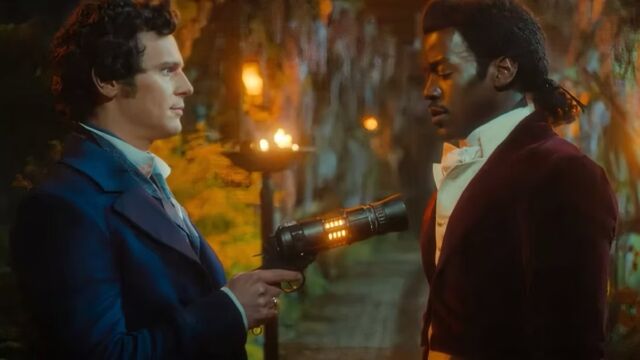
Enlarge / Sparks fly between the Doctor and a futuristic bounty hunter named Rogue in Regency England.
BBC/Disney+
Gatwa’s Doctor Who debut overlapped a bit with shooting the final season of Sex Education, so two of the episodes constitute what Davies calls “Doctor-Lite” because Gatwa has much less screen time: “Dot and Bubble” and the Ruby-centric “73 Yards”—actually the first episode Gatwa filmed, and among the most inventive Doctor Who episodes in recent years. Davies drew on Welsh folk horror for this haunting ghost story, bringing a smidgen of fantasy to the sci-fi series. The Doctor and Ruby arrive on the Welsh coast, where he accidentally steps on a fairy circle and mysteriously vanishes, just as Ruby notices a mysterious old woman standing on a distant bluff, gesticulating and saying something that Ruby cannot hear.
The apparition follows a confused Ruby into town, always staying 73 yards away. Others can see the woman but whenever Ruby asks them to go talk to her to find out what’s going on, we see their faces change, they look at Rudy, then run away in horror, insisting they never want anything to do with Ruby again. This goes on for decades. The TARDIS remains abandoned on that Welsh cliff with no sign of the Doctor. Ruby lives out her entire life with this apparition haunting her, estranging her from anyone she asks for help (including her own foster mother and UNIT). She does figure out how to use the apparition to avert nuclear catastrophe, however. On her deathbed, the ghostly woman finally appears right in front to Ruby—at which point Ruby is transported back to that first day on the Welsh clifftop and sees her younger self with the Doctor. This time, Young Ruby is able to warn the Doctor and stop him from breaking the fairy circle, and everything returns to normal.
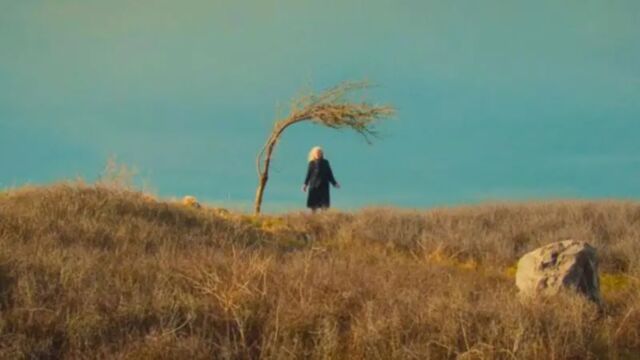
Enlarge / A mysterious woman in the distance haunts Ruby in “73 Yards”
BBC/Disney+
To say that some fans were flummoxed and unsettled by this episode would be an understatement. Davies is content to leave all the major questions unanswered. Who is the woman? What is she saying? We never find out for sure, although I interpreted the ghostly apparition to be Old Ruby traveling back through time at the end of her life to warn her younger self and the Doctor not to disturb the fairy circle, thereby setting things right. But it’s left deliberately ambiguous (Old Ruby and the apparition are played by different actresses) and that’s part of this episode’s lasting power.
All Davies has said is that “something profane” occurred when the Doctor disturbed the circle and Ruby “had to spend a life of penitence” and do something good in order to bring everything full circle. He said he would never reveal what the woman was saying, since this was the source of the horror. “It’s kind of up to you to sit there and think, ‘Well, what could someone say that make a mother run away from her daughter forever?'” he said. “Once you start to do that, you enter the real horror story, the dreadful things that are being said there.” As for the 73 yards, that’s the distance where a figure in the distance appears as “a blur but not a blur.” It’s also the distance of the perception filter around the TARDIS.
We do get an answer to the mystery of Ruby’s parentage, however, in the final two episodes, as well as a trip down Whovian memory lane. Throughout the season, strange phenomena have been manifesting around Ruby—usually it starts snowing, like it was the night she was abandoned as a baby, and sometimes we hear “Carol of the Bells” playing. The Doctor turns to UNIT for help analyzing the grainy VHS security footage of that night. This leads to the emergence of The One Who Waits (mentioned in “The Giggle”), aka Sutekh, the God of Death. Sutekh was the arch-villain defeated by the Fourth Doctor in 1975’s Pyramids of Mars storyline.
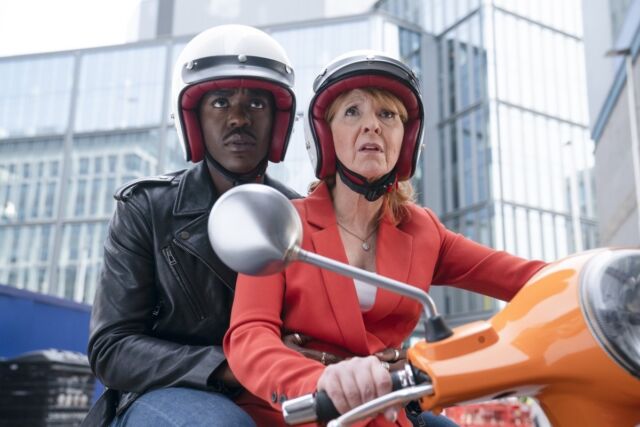
Enlarge / The Doctor reunites with former companion Mel Bush (Bonnie Langford) in the season finale.
BBC/Disney+
In “Empire of Death,” we learn that Sutekh actually attached himself to the TARDIS and his been tagging along on the Doctor’s travels through time ever since, through every incarnation. He releases his dust of death to kill everyone all through time, sparing only the Doctor, Ruby, and (initially) former companion Mel Bush (Bonnie Langford), who traveled with the Sixth and Seventh Doctors—mostly because Sutekh wants to know Ruby’s parentage too, convinced that her birth mother held the key to defeating him.
The joke’s on Sutekh (and on us), because Ruby turns out to the spawn of perfectly normal teenaged parents; Sutekh’s assumption that she was important is what made her significant, giving rise to all the mysterious phenomena. (Davies made that decision because he was frustrated with the Star Wars bait-and-switch concerning Rey’s parentage in the sequel trilogy—supposedly insignificant in The Last Jedi but revealed as Emperor Palpatine’s granddaughter in Rise of Skywalker.) The Doctor defeats Sutekh once again and everyone who turned to dust is magically restored. Ruby meets her birth mother and decides to search for her biological father while the Doctor continues on without her.
It’s a perfectly good Whovian finale to an excellent season that mostly sticks the landing. What’s next for Gatwa’s Doctor? We’ll have to wait to and see, but Gibson is expected to return next season—Davies has said her story is not yet finished—although we’ll also get a new companion, played by Varada Sethu. One might expect to see more of the Toymaker’s offspring going forward. And Ruby’s quirky neighbor, Mrs. Flood (Anita Dobson), is clearly not what she seems, breaking the fourth wall at finale’s end to tell us the Doctor’s story will end in “absolute terror.” So, business as usual then. We’re here for that.
All episodes of Doctor Who‘s fourteenth season are now streaming on Disney+.


